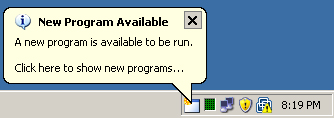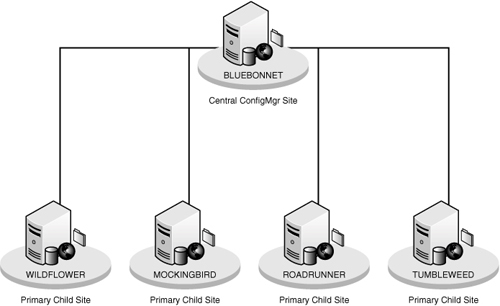Standardization
The most
successful implementations of SMS, or any other software distribution
tool, historically have been in standardized environments. Standardizing
operating systems, patch levels, application loads, hardware, and
overall configuration allows administrators to test their deployments
before rolling them out to the enterprise. Hardware-independent imaging,
only recently a reality, allows administrators to build a single image
and inject drivers on the fly during the deployment process. This
process allows you to use one image for any number of hardware
manufacturers and models, creating the most standardized OS deployment
process available today.
Inventory allows
administrators to logically group systems by any combination of hardware
and software. This inventory data is useful in defining deviations from
the standards created by an organization. Inventory data allows
organizations to see the software installed on client systems, and
software metering allows organizations to see the software executed on
client systems. Analyzing these two sets of data helps organizations
make educated decisions regarding software deployments and licensing.
Operating system
deployments and migrations allow organizations to standardize their
environment, thus controlling installations and configurations at the
operating system and application level. Historically, operating system
deployments have been a manual and time-consuming process, making it
extremely difficult for large organizations to standardize their
environment. Now operating system deployments are easier than ever,
allowing levels of standardization that previously were out of reach due
to technology, resources, and expense.
Remote Management
Information
Technology has increasingly become a top expense in today’s
organizations. The ability to resolve issues quickly after they are
identified requires tools that the first tier of support (usually
referred to as Tier1)
can use to perform tasks as though they were at the end user’s system.
These tools are critical to managing and lowering TCO of IT assets.
Tools such as
Remote Control, Remote Desktop, and Remote Assistance give
administrators the ability to run commands, see the hardware and
software installed, and above all see the user interface the user is
seeing. This type of remote control support has become an industry
standard for remote user support. Branch offices and micro-branch
offices, which have fewer than 10 users, have become increasingly common
as corporations change and grow to stay competitive. These business
models further complicate the remote management issue, making site
visits not an option and remote tools critical to the support of the
environment.
Software Distribution
Deploying software is one
of the most primary functions of any Information Technology group.
Getting users the applications, updates, security patches, and other
changes required to keep an environment running is critical to a
business’s success. For any company to stay agile in today’s market, IT
must be able to adapt and meet the business’s needs in a timely,
efficient, and inexpensive manner. Being able to deploy software to
systems, regardless of location and user’s knowledge or rights of a
system, is critical.
There are two primary
methods to get a software update to a system—push and pull. Each of
these methods ultimately gives the targeted systems the software desired
for roll out, but there are many differences between the two and
neither is necessarily right all the time.
Pulling Software
“Pulling” implies
that the owner or recipient of the package must initiate some action.
This allows the recipient to initiate the change when it is convenient,
thus minimizing the impact on productivity. Allowing a user to pull down
an application and install it at his or her leisure is also useful for
rolling out software with user-specific settings the recipient needs to
specify during installation. Even on locked-down systems where users
have no rights, the end user can initiate and execute software
installations as long as they were set up and approved by the IT
administrative staff. Figure 1 illustrates the end-user notification that a program is available for installation.

The
problem with a software change sent out in a “pull” fashion is that
without that user initiation, the change never occurs. You can see how
this will be a problem where there are changes that must take place on
systems due to company policy. This could also be something a user may
not want to do, such as removing a personal application from a company
asset. This type of application distribution typically takes place when
the users are very self-sufficient and avoiding negative impact to the
end user is important.
Pushing Software
“Pushing” software
speaks to the process of forcing changes to be rolled out in the
enterprise. Pushing does not require user interaction, and it can be
executed like policy. In fact, pushing software assumes there is no
requirement for user interaction, although a need for user interaction
with the installation routine does not prohibit an administrator from
pushing it out. You can push software whether or not a user is logged on
to a system, unlike a pull, where the user must be logged on to
initiate the change. This ability to kick off a change on systems with
no one logged on addresses multiple items:
It eliminates file-locking issues
It removes disruption to the end user’s productivity
Systems may be shut down afterward, allowing the user starting up the computer to complete a reboot cycle.
Installation duration is not an issue because there is no user impact.
Systems may be woken up using Wake On LAN technology to kick off an installation.
Users are unable to interrupt the installation.
To Pull or Push
Although neither
of these methods of applying changes solves all scenarios, it is easy to
see how each can be used in conjunction with the other to address all
types of requirements for change, configuration, and release management.
Minimizing Impact on the Network Infrastructure
Networks are critical
to the daily functions of corporations today. Due to the heavy demand
placed on networks, ConfigMgr utilizes several concepts and technologies
to minimize the impact it places on the network infrastructure. Many of
these technologies can be configured centrally, allowing other
administrators to leverage the ConfigMgr architecture without needing
deep knowledge of the enterprise’s network infrastructure. Technologies
such as BITS, distribution points, branch distribution points, download
and execute, senders, and compressed XML are just a few of the
technologies available.
BITS—
BITS monitors traffic in and out of the local network interfaces and
throttles itself throughout a download, utilizing only the available
idle bandwidth. This minimizes impact to the user experience with other
network-aware applications, such as Microsoft Outlook or Internet
Explorer.
As
users’ demand increases for more data from their applications across
the network, BITS throttles itself down; as the demand drops, BITS
throttles itself up to use as much bandwidth as available.
Distribution Points is
important to understand that you can place distribution points anywhere,
and it is not unusual to have multiple DPs on a single subnet! This is a
common architectural design if there is a high demand to run packages
from the distribution point or a large number of clients. A common
design is to implement multiple DPs in a single location when there are
concerns about router contention or high switch traffic.
Branch Distribution Points gives ConfigMgr the ability to push a package across a WAN
link to a location with a very small number of clients and only traverse
the WAN link one time with the package. SMS 1.x through 2003 pushed a
separate package over the WAN link for every client in the remote
location. Although third-party software existed to address this SMS
architectural deficiency, it was costly and not well known. Now with
support available for a client workstation to be a distribution point,
the branch office or microbranch office model can easily be targeted and
have packages pushed to it.
Whereas ordinary distribution points have packages published (also referred to as copied or pushed)
to them by the ConfigMgr administrator, branch distribution points
receive their package copy by updating their policy and then downloading
the package source using BITS. This pull process is the opposite of how packages are ordinarily published to conventional distribution points.
Download and Execute—
Download and Execute is a feature introduced in SMS 2003; it leverages
the BITS technology to cache a copy of the package from the DP. Many
people ask, “Why would I want to cache a copy of a package if I have a
local DP?”
The reason is
quite simple: When packages are assigned, they are mandatory and will
launch at the time stated in the advertisement. Because Kerberos tickets
are time sensitive, clocks on computer systems today all synchronize
with the clock on the PDC Emulator DC. This means that all clients with a
mandatory advertisement will start it at exactly the same time, thus
placing a heavy load on the local distribution point. The Download and
Execute capability gives administrators the ability for clients to cache
a copy of the package and upon execution, perform the installation from
their local hard drive. BITS allows administrators to configure many
things about its behavior, including how long to hold the copy of the
package in its cache.
Senders—
Senders allow the throttling and prioritization of traffic by time
between ConfigMgr sites. Administrators often overlook configuring
senders, leaving the default of allowing all traffic at all times of the
day. Without configuring senders, there is no throttling, and the
network infrastructure may be utilized by traffic that could have waited
until nonpeak hours of the day. Whenever parent/child relationships exist, you should experiment with senders to determine what is right for the environment in regard to time of day and workload.
Inventory—
Even at the inventory level, there are changes allowing a more
efficient use of the technology now available. Hardware and software
inventories are generated by their respective agents, with the output
created in XML. This XML file is then compressed and sent up to the MP
immediately. If the MP is not available, the client caches the inventory
until the next time it is available or until the next inventory
schedule, where it is rerun.
Testing—
With all this technology available to tread the network lightly, it is
important to experiment with these settings in a lab environment. It is
not uncommon for administrators to make mistakes that will saturate WAN
links due to the nature of the product. Test whenever the ability exists
to affect a network in a negative way, confirming in advance that the
experience will be a positive one. Experimenting with different site
configurations, package pushes, and client package execution can
determine the overall load on the site, network, and distribution
points.
Creating a lab
for ConfigMgr is not only necessary for validating the site hierarchy
and load testing, but it can also be used for package, security, patch,
and upgrade testing. The
lab incorporates a central site server (Bluebonnet) and four primary
child site servers:
Wildflower— DAL site
Mockingbird— HOU site
Roadrunner— BEJ site
Tumbleweed— BXL site
